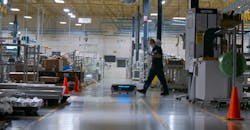How Autonomous Robotics Can Improve Productivity
It’s not news that manufacturers across the globe are feeling the pressure to keep up with high market demands. Scarce labor markets, changes in consumer buying expectations and supply chain disruptions are challenging manufacturing leadership to keep productivity steady enough to meet market demands, stay competitive, and quickly adapt to a fluctuating landscape.
To address these market forces, manufacturers are seeking technology solutions that will support their workforce by eliminating the need for human intervention for non-value-added, or repetitive tasks to improve productivity.
Helping lead the way to greater productivity, autonomous mobile robots (AMRs) play a critical role in not only reducing the strain on human workers and freeing up their time for value-added tasks, but also creating a safer work environment.
When evaluating AMRs for your environment, here are some key considerations to help ensure your new AMR is the right fit for your workplace.
Autonomous Navigation
Unlike alternatives like automated guided vehicles (AGVs), which require predefined routes, markers or guides and require human intervention to change routes, an autonomous mobile robot can navigate autonomously through the environment. How the robot autonomously moves around is arguably one of the most important considerations for evaluating an AMR. However, there are multiple navigation types available on AMRs to consider—the most common being laser and vision, usually supplemented by QR codes, reflectors, etc.
While all navigation types have their purposes, it is recommended to use autonomous mobile robots equipped with laser-based, SLAM-based (Simultaneous Localization and Mapping) technology. The reason being that this navigation type is more flexible than its counterparts—allowing the robots to be more adaptable to highly-dynamic. In a rapidly changing environment like manufacturing, this adaptability is critical to ensure the solution can scale with demand. But all laser-based technology isn’t made equal, so digging into the details is critical.
In addition to greater flexibility, laser-based navigation can also help save costs in implementation and reduce headaches down the road.
Safety Features
Safety is one of the large draws for implementing AMRs into workflows. Alternative transport options, like forklifts, have a high accident rate and bring up a safety concern. Stats show that 90% of all forklifts in the US will be in an accident during its lifecycle and approximately 35,000 people per year suffer severe injuries from forklift-related accidents. Additionally, manufacturing environments often require repetitive tasks that can put strain on workers’ bodies and cause long-term damage. Not only do AMRs replace more accident-prone machines like forklifts, but they can also take over the repetitive tasks that can cause injury.
While implementing an AMR will help create a safer work environment, it is still recommended conducting a thorough hazard assessment of the robot in consideration, as it will be collaborating with human workers.
Recommended questions to ask during the assessment include:
• How does the AMR detect and avoid obstacles?
• Does it comply with any ISO/ANSI standards?
• How wide is its obstacle detection radius?
• How does the vendor/integrator evaluate risk?
• Can the AMR be integrated into the fire alarm system so it automatically moves to a safe location during an emergency?
Keep safety at the forefront of the evaluation and do your due diligence to make sure you have an in-depth understanding of what features are in place to ensure the AMR will interact safely with your workforce.
Battery Type and Life
Battery strength is a critical consideration when evaluating a robot. After all, the battery equates to the AMR’s reliability. And, if improving productivity with the AMR is the goal and the bot isn’t functional half the workday due to lengthy charge times or short battery life, is it even achieving its goal?
There are a lot of techniques out there to optimize the life of a battery. But starting off with an AMR with a high-quality, reliable battery and charging parameters is the best way to maximize throughput and uptime.
To help ensure the AMR will have a reliable battery life, you should ask vendors questions such as:
• Does it support automatic charging and opportunity charging?
• What parameters are adjustable to maximize availability/up-time?
• How fast does it charge?
• What voltage is required?
While seemingly a small part of the overall AMR, the battery and its capabilities play a large part in the user experience.
Payload Capabilities
There are a wide range of payload capacities available for AMRs—typically 500kg and below and 1000kg and above. However, when considering an AMR, take a forward-thinking approach when evaluating payload needs. Just because you have 500kg applications now, doesn’t mean 1000kg applications aren’t a possibility. If you have an application in the future with larger payloads, you want the flexibility of AMRs that can adapt to your business growth.
Oftentimes, the higher the payload and bigger the size of the AMR, the more expensive it is to implement. To help determine if you have the flexibility of a higher payload bot at the cost and size of a lower payload bot, consider comparing the cost and size of the AMR with competing products.
There are many different styles and types of AMRs on the market right now—forklift, mobile pallet conveyors, goods-to-person, person-to-goods, towing, etc.—each with a different purpose and pros & cons. Ultimately, it’s important to remember that an AMR is most effective when it integrates into a comprehensive factory automation system. Mobile conveyors complement other key factory automation solutions including conveyors, aluminum framing, linear motion systems, and more. It’s not just an AMR. It’s one component of an automation ecosystem.
Chris Mercurio is product manager for AMR/robotics at Bosch Rexroth, a supplier of drive and control technologies.
About the Author
Chris Mercurio
Chris Mercurio is product manager for AMR/robotics at Bosch Rexroth, a supplier of drive and control technologies.
